Figure 1.
Schematic representation of human and mouse Nf1. (a) Human Nf1 on chromosome 17 encodes a 2818--amino acid protein called neurofibromin. Small boxes represent exons. Black boxes indicate exons 21 to 27a that encode the GAP-related domain (GRD). Alternatively spliced exons are marked by arrows. Disease-causing mutations are widely distributed throughout the entire Nf1 gene and most of those result in loss of function of its protein product. (b) Top: the mouse Nf1 gene on chromosome 11 has a structure very similar to that of human Nf1 gene and encodes a protein with 98% identity to human NF1. Middle: Nf1 null mutant mice were generated by inserting a neomycin cassette in exon 31 (Jacks et al. 1994). Gray box indicates exon 31 including the neo gene. Bottom: conditional mutants were engineered by inserting loxP sites flanking exons 31 and 32 (Zhu et al. 2001). loxP sites are indicated by triangles. Delivery of Cre recombinase by crossing with Cre-expressing transgenic line or viral vector enables cell type-- specific deletion of Nf1.

